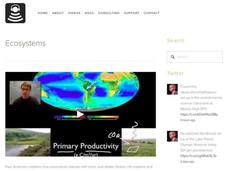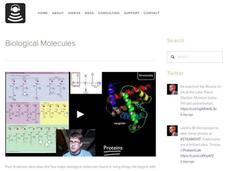Bozeman Science
The Greenhouse Effect
How do we know global warming isn't just mother nature having hot flashes? The video describes the greenhouse effect and how it is necessary to life on this planet. Then it explains greenhouse gases and how increasing them can lead...
Bozeman Science
Ecosystems
Living and non-living things are both a part of an ecosystem. A video begins with ecosystem interactions using biotic and abiotic factors. It also covers food webs, limiting factors, and logistic growth. As a real-world connection, it...
Bozeman Science
Biotic and Abiotic Factors
Don't be a lone wolf, learn how the reintroduction of wolves in Yellowstone Park altered the biotic and abiotic factors. Video describes the impact of biotic and abiotic factors at multiple levels. It highlights the examples of food...
Bozeman Science
Biological Molecules
Focus on macro-molecules including nucleic acids, proteins, lipids, and carbohydrates. A video explains which are monomers, which form polymers, and the process of changing from one to the other. It also covers the characteristics of...
Bozeman Science
Transport Across Cell Membranes
Materials don't need a password to move through cell membranes! Learners explore how cells move materials across the cell membrane. The video then teaches the detailed workings of both passive transport (specifically diffusion,...
Bozeman Science
The Importance of Oxygen
Wow, the human body is complex! The video explores the importance of oxygen, beginning with exploring why it is needed in combustion and then moving into an organism's need for oxygen. Learners see how glucose, when combined with oxygen,...
Bozeman Science
Life Requires Free Energy
Free energy, get your free energy here! Learners see that all organisms require free energy, which comes from the sun. The lesson explains the first two laws of thermodynamics and then analyzes metabolism, via glycolysis, on a very...
Bozeman Science
Homeostatic Evolution
How does something remain the same in order to change? The video discusses homeostatic evolution from both the continuity and changing perspectives. An analysis of the excretory system in flatworms, earthworms, and vertebrates shows...
Bozeman Science
Evolutionary Significance of Cell Communication
Explore how cells communicate with a video that features the symbiotic relationship between a bioluminescent bacteria and the bobtail squid. The resource explains quorum sensing in bacteria and how epinephrin is linked to glycogen...
Bozeman Science
Diploid vs Haploid
If every human on earth looked exactly the same, the world would be a boring place. Thank goodness for genes! Pupils explore the difference between haploid and diploid cells by learning how two parents without red hair can produce a...
Bozeman Science
Cellular Variation
Variety truly is the spice of life. A video explores how plants have both chlorophyll a and b and the benefits of possessing both, how varying molecules allows for winter wheat, how possessing the heterozygous combination of sickle-cell...
Bozeman Science
What is Cancer?
This year, an estimated 1,685,210 new cases of cancer will be diagnosed in the United States, and 595,690 people will die from the disease. Learners define cancer, see how and why it grows in the body, how doctors can treat it, and what...
Bozeman Science
Compartmentalization
Kleenex folded in a box is similar to mitochondria in a cell. Llearners explore how eukaryotic cells have specialized organelles that increase the surface area of the cell without making it smaller. E.coli, Halobacteria, and...
Bozeman Science
Cellular Organelles
Despite their microscopic size, eukaryotic cells are probably one of the most complex systems ever! Explore the structure and function of the major organelles of eukaryotic cells — the nucleus, ER, ribosomes, golgi complex, lysosomes,...
Bozeman Science
Cell Membranes
Explore the structure of cell membranes including cholesterol, glycolipids, glycoproteins, phospholipids, and proteins. The video shows and discusses the fluid mosaic model as well as how cell walls differ from cell membranes.
Bozeman Science
Cell Division
It is hard to believe a 300-foot-tall Redwood tree began as a single cell hundreds of years ago. How did it grow so large? Observe how different kinds of cells (bacteria, sex cells, and eukaryotic cells) reproduce or make more cells...
Bozeman Science
Cell Communication
Humans have taken communication to every corner of the Earth, yet our bodies, at the cellular level, have communicated without technology for millions of years. Learners view the variety of ways cells can communicate, whether right...
Bozeman Science
A Tour of the Cell
Adult humans are made of around 40 trillion cells that can't be seen these without some really powerful microscopes! Learners tour both prokaryotic and eukaryotic cells, learning how their structures are similar and different, and...
Bozeman Science
ESS3D - Global Climate Change
Climate change has severe consequences to the future of our world. Through specific examples, a video instructor explains the causes and outcomes of the changing climate. He also gives advice on how to present the information across...
Bozeman Science
ETS1C - Optimizing the Design Solutions
Engineering design makes the things we use every day possible. The video lesson highlights the criteria approach to optimizing a design solution. The narrator explains a sliding scale method to arriving at the best solution.
Bozeman Science
ETS1B - Developing Possible Solutions
Teach the engineering steps for developing problem solutions. The video instructor explains the steps of the process from different perspectives. He discusses how to approach a problem in early elementary all the way through advanced...
Bozeman Science
ETS1A - Defining and Delimiting an Engineering Problem
Explore the meaning of an engineering problem-solving process. By defining specific world problems, the narrator emphasizes the importance of engineering in our world. He outlines the engineering process and connects the information to a...
Bozeman Science
ESS3A - Natural Resources
Explore the natural resources on earth in relation to the specific Next Generation Standard. Understanding these resources are not evenly distributed in all locations helps gain a perspective of their uses. Nonrenewable...
Bozeman Science
ESS2A - Earth Materials and Systems
The water we use today is the same water our ancient ancestors used. A comprehensive video lesson explains this concept and many others as it explores the earth's materials and systems. From the geosphere to the atmosphere, the narrator...























